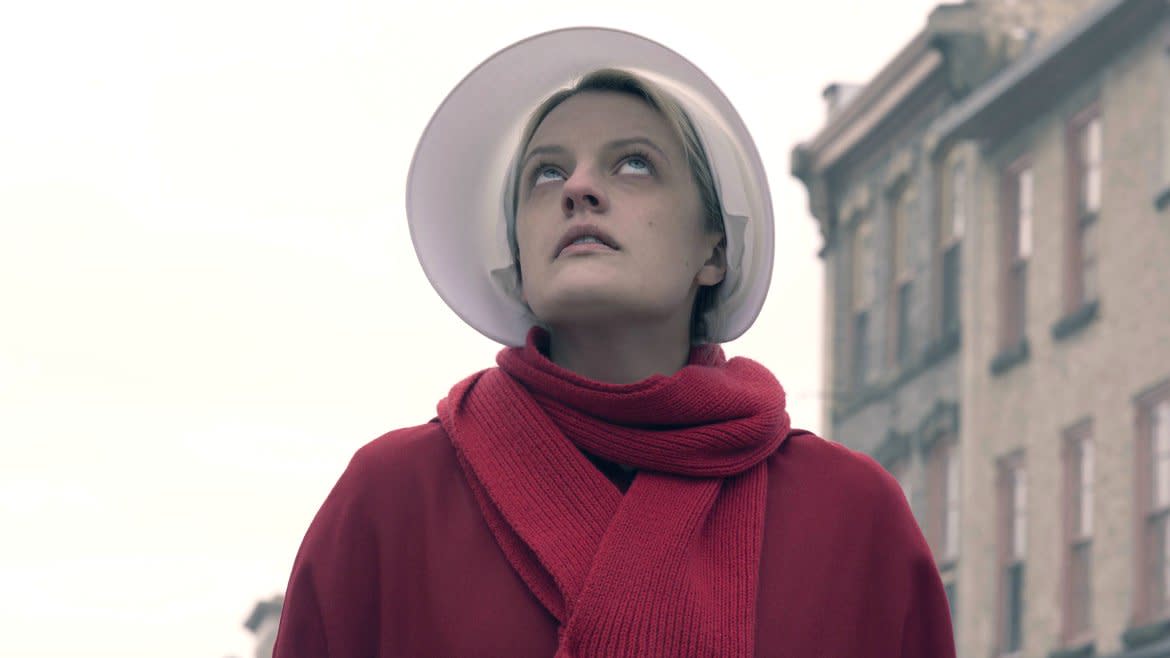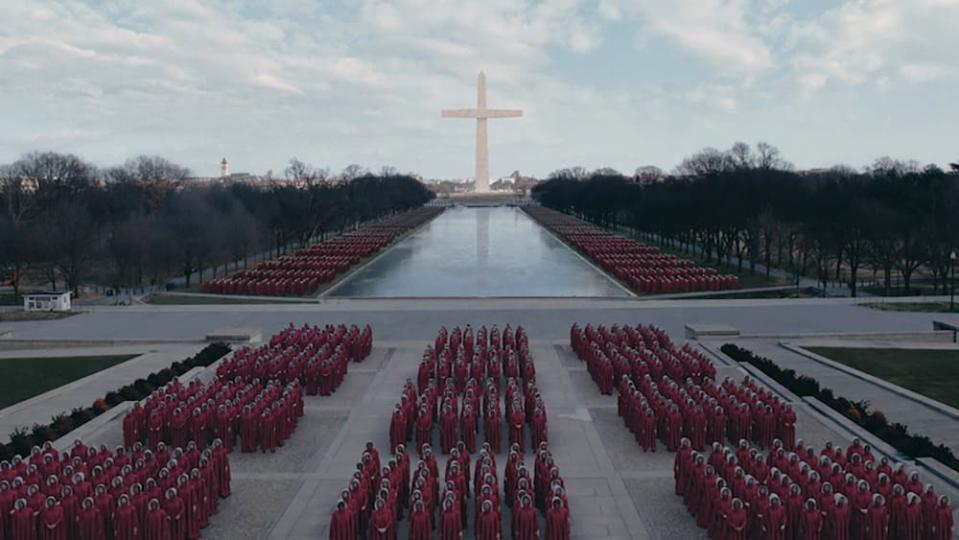Elisabeth Moss on ‘The Handmaid’s Tale’: ‘I Can Barely See the Line’ Between TV and Reality

It’s a haunting image: hundreds of women in red cloaks and white bonnets, heads turned downward, arranged in ordered lines at the base of the National Mall’s reflecting pool, all facing the Lincoln Memorial. In the shadow of the Washington Monument, they all kneel in unison.
When cast members from The Handmaid’s Tale were spotted filming in D.C. for the third season of the Hulu drama series, some people were unsure of whether they were watching the television production or a group of actual protesters. Since the Emmy-winning adaptation of Margaret Atwood’s 1985 novel premiered in 2017, the disquieting resonance of the dystopian story—a regressive patriarchy begins stripping away women’s rights—has inspired real-world political activism.
Women in handmaid outfits has become a form of resistance cosplay. Two years ago, a dozen women dressed in them marched into the Texas Senate gallery to protest a bill restricting abortion access. Since then, the look has gone global.
Handmaids gathered for protests in Ireland and Argentina. They were outside Brett Kavanaugh’s Supreme Court confirmation hearings. As Alabama and Georgia introduced anti-abortion laws, they’ve been mainstays outside the state legislative buildings. Wired called the outfit “the viral protest uniform of 2019.”
“When I see those women wearing handmaid costumes and marching and protesting in them, I’m even more proud to put it on,” Elisabeth Moss, who plays the central character of June and is an executive producer on the series, says. “I know what that costume stands for and what it means, and that’s inspiring.”
‘The Handmaid’s Tale’ Author Margaret Atwood Warns That Under Trump ‘This Might Actually Happen’
The show’s third season premiered Wednesday on Hulu amid a smattering of press remarking about how difficult it is to delineate what’s going on in the real world from the fictional events unfolding on screen.
You could watch women address Congress about rolled-back reproductive rights on the news, and then screen an episode of the series in which June says, “There was a time when women were able to choose. We were a society dying, Aunt Lydia would say, of too much choice.”
“And, God, I wrote that a year-and-a-half ago,” series creator Bruce Miller says.
The Handmaid’s Tale debuted in the first months of the Trump administration, when the violent regressiveness of Gilead was an eerie cautionary tale. As season three premieres, however, circumstances that once seemed catastrophic now, to some, seem inevitable. “I would love for our show to be irrelevant,” Miller says. “That’s the goal.”
The new season of the series tackles new territory, though, once again, uncannily reflecting back the current political and cultural climate. After making the controversial decision not to flee Gilead in a getaway car—instead giving her newborn daughter to another handmaid to run away with so that she could stay behind and save her other daughter—June is powered by rage. You see a transformation in the closing shot of season two, which zooms in on Moss’s face as her eyes seethe with intensity.
“I call it the Jedi image,” Miller says. “The idea I had is like a boxer coming out into the ring with a hood on their head. June is ready to fight.”
She risks her life gathering support for a resistance, even trusting in her former employer and abuser, Serena Joy (Yvonne Strahovski). What she learns is that resistance isn’t as simple as picking up a banner and marching outside the Gilead offices. Systemic change is complicated, and dangerous. It requires realizing and reckoning with the fact that, as dire as circumstances might already seem, they could get so much worse. As Moss says, “She thinks Gilead is bad. She has no fucking idea.”
Miller knows June’s decision to stay behind was polarizing. The split, passionate reaction to the season two finale wasn’t surprising; it was the same situation in the writer’s room. “We couldn’t put our minds around either choice,” Miller says, adding that following June to Canada would have been its own great TV show. “It was a 51/49 split about which to do. We argued for months about it.”
One could argue that June “getting out” would have been too optimistic. There’s certainly something relatable about witnessing her anger and desperation as she tries to lead a resistance while trapped in a society that is escalating its oppression.
It leaves you breathless to recount the ways in which the news today mirrors what is happening in the series, from anti-abortion bills to attacks on LGBTQ rights. Then again, Atwood’s novel has resonated for three decades. The issues it deals with—the dynamics of gender, of power, of sex, of fertility—are arguably things that we will be dealing with forever.

“We live in this world, and those things influenced us and they should influence us as writers and as actors and as artists,” Miller says. “I don’t think we try ever to bring our world into Gilead. What we do is try to follow Gilead, which in the end makes it a lot more disquieting when it does end up being the real world.”
Still, there is something to how “the real world is starting to resemble The Handmaid’s Tale” has morphed from clever media packaging of the news into something much more haunting over the last three years of the show’s run.
“I hope that people take it that seriously,” Moss says. “I hope that they don’t just treat it as a catchy thing to say. I hope they take that feeling and put it into action. I hope that people take their feelings of frustration about the show’s relevance and actually do something about it.”
She still gets goosebumps recounting what it was like to film with the ensemble of handmaids in D.C. She was standing on the steps of the Lincoln Memorial facing 200 women dressed in the red cloaks and white bonnets, the Washington Monument rising behind them; the White House just blocks away. As June, she’s channeling rage: “It feels that line between entertaining television show and real life, at that point I can barely see it.”
Got a tip? Send it to The Daily Beast here
Get our top stories in your inbox every day. Sign up now!
Daily Beast Membership: Beast Inside goes deeper on the stories that matter to you. Learn more.

